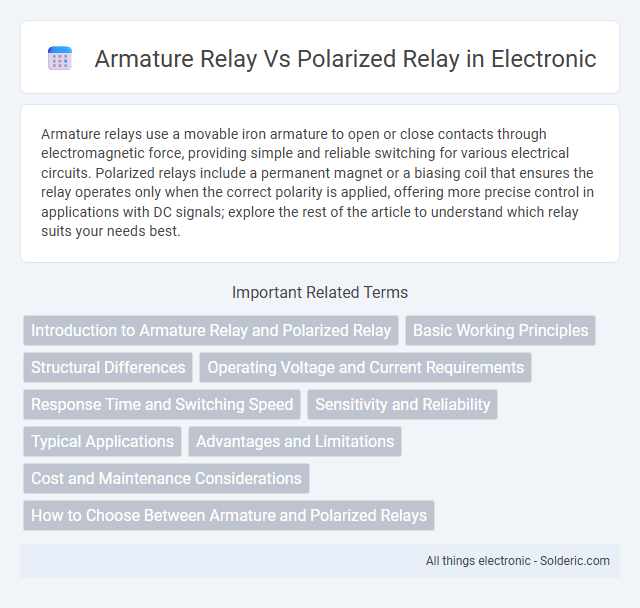Armature relays use a movable iron armature to open or close contacts through electromagnetic force, providing simple and reliable switching for various electrical circuits. Polarized relays include a permanent magnet or a biasing coil that ensures the relay operates only when the correct polarity is applied, offering more precise control in applications with DC signals; explore the rest of the article to understand which relay suits your needs best.
Comparison Table
| Feature | Armature Relay | Polarized Relay |
|---|---|---|
| Operating Mechanism | Electromagnetic armature movement | Electromagnetic with permanent magnet polarity |
| Sensitivity | Less sensitive | High sensitivity due to polarization |
| Contact Type | Standard mechanical contacts | Contacts influenced by magnetic polarity |
| Application | General switching tasks | Directional and precise switching |
| Response Time | Moderate response | Faster due to polarization |
| Cost | Lower cost | Higher cost |
| Complexity | Simple design | More complex design |
Introduction to Armature Relay and Polarized Relay
Armature relays operate using a magnetic armature that moves to open or close contacts based on the electromagnetic field generated by the coil. Polarized relays include a permanent magnet that maintains contact polarity, ensuring consistent operation in DC circuits where direction of current is critical. Your choice between armature and polarized relays depends on application demands for sensitivity, polarity detection, and circuit type.
Basic Working Principles
An armature relay operates by using an electromagnet to move a hinged armature, closing or opening contacts based on the magnetic field generated when current flows through the coil. In contrast, a polarized relay combines an electromagnet with a permanent magnet to provide directional sensitivity, ensuring accurate response to current flow polarity. Your choice between these relays depends on whether you need simple magnetic switching or polarity-sensitive control in your circuit.
Structural Differences
Armature relays feature a movable iron armature that directly opens or closes contacts, relying on magnetic attraction for operation. Polarized relays contain a permanent magnet and an armature influenced by both magnetic fields and electrical polarity, enabling directional sensitivity. Structural differences lie mainly in the armature design and the presence of a permanent magnet in polarized relays, which affect their response characteristics and application suitability.
Operating Voltage and Current Requirements
Armature relays typically operate at a wider range of voltages, often handling higher current loads between 5 to 30 amps, making them suitable for general-purpose switching tasks. Polarized relays require a specific polarity and usually function at lower currents, around 0.5 to 5 amps, relying on a permanent magnet to maintain stable operation under precise voltage conditions. Your choice depends on whether your application demands robust current capacity and flexible voltage use or sensitive, polarity-dependent switching performance.
Response Time and Switching Speed
Armature relays typically exhibit slower response times and switching speeds due to mechanical inertia in the moving armature, often measured in milliseconds. Polarized relays feature enhanced switching speed by utilizing magnetic polarization to reduce armature movement distance, leading to quicker activation and release. Your choice between these relays should consider the required response time for your application, as polarized relays offer superior performance for faster switching needs.
Sensitivity and Reliability
Armature relays exhibit moderate sensitivity and high reliability due to their robust mechanical construction, enabling consistent operation under varying voltage conditions. Polarized relays offer greater sensitivity as they respond to both magnitude and polarity of current, making them ideal for applications requiring precise detection of directional current flow. Reliability in polarized relays depends on maintaining proper polarization voltage, which, if disrupted, can reduce their accuracy and operational dependability.
Typical Applications
Armature relays are commonly used in industrial control systems and automation processes where reliable switching of high current circuits is required, such as motor starters and lighting controls. Polarized relays find typical applications in telecommunication equipment and measurement instruments, where precise control and minimal contact wear are crucial for detecting small signal changes. Your choice depends on whether you need rugged switching capabilities or sensitive operation for low-current, signal-level tasks.
Advantages and Limitations
Armature relays offer advantages such as simple construction, high reliability, and fast response times, making them suitable for general-purpose applications. However, their limitations include susceptibility to vibration and limited sensitivity to low current signals compared to polarized relays. Polarized relays provide enhanced sensitivity and stable operation under varying electrical conditions but are generally more complex and expensive.
Cost and Maintenance Considerations
Armature relays are generally more cost-effective due to their simpler design and widespread availability of parts, making them easier and cheaper to maintain. Polarized relays require more precise components to maintain their polarization effect, resulting in higher initial costs and more specialized maintenance. Maintenance for armature relays often involves routine lubrication and contact cleaning, while polarized relays demand more frequent calibration to ensure reliable operation.
How to Choose Between Armature and Polarized Relays
Choosing between armature and polarized relays depends on the application's voltage sensitivity and switching requirements. Armature relays operate using an electromagnet to move contacts and are suitable for general-purpose switching with lower sensitivity to polarity. Polarized relays contain a permanent magnet that interacts with the magnetic field generated by the coil, offering precise control in DC circuits where coil polarity and rapid response are critical factors.
armature relay vs polarized relay Infographic

 solderic.com
solderic.com